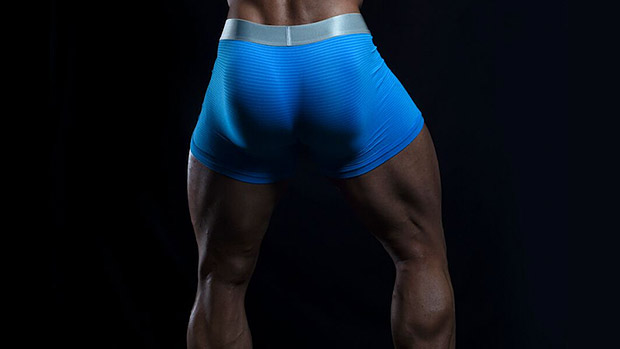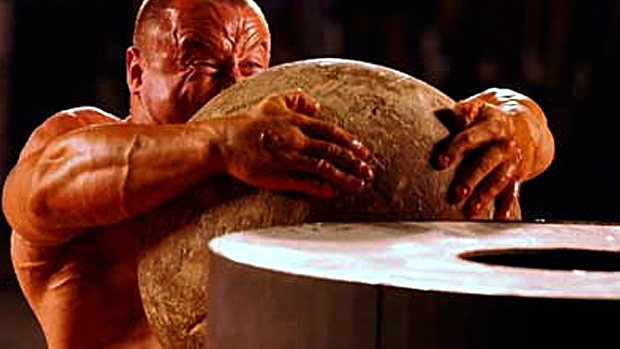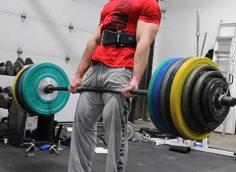What do T-mag assistant editor Chris Shugart and Jean Claude Van Damme have in common? Aside from wacky accents and constantly having to save their families from drug dealers and terrorists, both of them have, at one time or another, claimed to be able to crack walnuts with their respective butts. I don't know whether that claim is true and frankly, I don't want to find out. I even heard there's a video of some "competition" they had, which is currently floating around on the Internet, but I have no plans to download that particular clip!
Whatever the circumstances surrounding that rumor, it's pretty clear that both men have a lot of confidence in their backsides. And with good reason – they have strong glutes. You can be sure that walnut crackin' ass cheeks are the result of years of heavy, rigorous training, but there are reasons above and beyond this somewhat dubious party trick to add some glute-specific work to your training program.
Why train the glutes?
Lots of reasons!
1) The glutes are hit in a variety of exercises, but few people perform direct glute training. Isolation work is done for the hamstrings, lats, traps, and spinal erectors; however, the gluteus muscles are often overlooked.
Even if you utilize primarily multi-joint compound movements which involve the glutes, it's possible to create an imbalance in the posterior chain if you perform a lot of isolation movements for other muscles. Clearly, this isn't optimal and should be avoided. Training the glutes directly can help minimize the risk of such an imbalance occurring.
2) Obviously, one of the main reasons to train the glutes in a relatively specific manner is for increased strength, which is the primary goal of this program. As part of your posterior chain, the gluteus maximus acts as an important mover in both Olympic and power lifts. (2,5,9,13,15) Increasing glute strength can lead to increased poundages in the squat, deadlift, snatch, and so forth. For example, the glutes are recruited more heavily as squat depth increases. (2,15) As such, we can assume that increased glute strength will allow you to move more weight from the "basement" of a squat.
3) The glutes are also involved in any hamstring exercise that involves trunk flexion/extension. (3,11,16) This includes the stiff-legged deadlift, good mornings, and any variation of either. It's also been shown that as load in these movements increases, the greater the glute involvement becomes. (3) This is something to take into account when considering glute training. As glute strength grows, more weight can be used during trunk flexion/extension exercises. Hamstring strength, resultantly, will also increase, with respect to these movements.
It should also be noted that this may help to indirectly increase your squat, as the hamstrings will play a larger role in the squat as load increases.(9) As a result of these factors, greater overall lower body development seems possible.
4) Athletes involved in any dynamic sport should also consider glute training as there's substantial involvement of the gluteal muscles in both jumping and sprinting, especially in the initial explosion of either. (1,4) From this we can infer that increased strength may lead to increased initial power output, having great carryover to sports. The benefits of such training would also obviously apply to anyone who uses sprinting routines such as HIIT as their mode of cardiovascular activity.
5) As with any other aspect of bodybuilding, the scope of training this particular body part goes beyond functionality and strength to fully encompass aesthetics. Although it's occasionally debated, there seems to be a positive relationship between heavy strength training and both neurogenic and myogenic tones. (6,7,8,12,14) That is, training heavy will increase both.
Due to this, you'll see increased density, tone, and all of the other benefits of such training. This matters for one very simple reason: chicks dig a hard butt. (10)
(For more information on the effects of strength training on neurogenic and myogenic tone, check out Joel Marion's Ripped, Rugged and Dense program.)
6) Walnuts, baby. Walnuts.
Quick FAQ
Before we get into the training program, let me answer a few common concerns many people have whenever the topic of glute training comes up.
Q: Will this program give me a big fat ass?
A: No. Even if you use the program for hypertrophy, you won't experience enough growth to warrant the use of that term. Consider this: unless you're genetically predisposed to having a very large tushie, your growth will be fairly limited. If you are someone with a big bottom, then you'll obviously not use the program for hypertrophy.
The program outlined below is primarily for strength. If you're overly concerned about increasing the size or your butt, simply don't use the program in the presence of a caloric excess, without which growth can't occur. Generally speaking, glute training changes the shape of your butt much more so than the size. If anything, it'll give your butt a rounder look.
As for fat, that's a fairly complicated issue. First off, no training program creates fat; that's a function of a poor diet. We know that women tend to hold fat in the thighs and buttocks, and this program won't change that. It isn't designed for spot reduction either, but in combination with the correct diet, it'll help improve the overall look of the area.
Q: Does training the glutes make me gay?
A: No, enjoying sex with other guys makes you gay. Training the glutes makes you strong.
Q: How do I fit this routine into my current training schedule? Does it replace leg days?
A: If you split your leg workouts into Ian King-style hip dominant and quad dominant days, this program will fit in best on your hip dominant leg day. If you only train legs once per week, alternate this routine with your other, more traditional leg workout on a weekly basis.
Q: Can overtraining the glutes create an imbalance?
A: Yes, absolutely. The potential is there as much as it is with any other muscle; however, it's highly unlikely with this program. Although the glutes are the main muscle worked in most of the prescribed exercises, all of the movements are compound. Keep in mind that glutes are frequently neglected, and if anything this program may help correct any already existing imbalances.
Q: How long should I stay on this program?
A: Like any other training program, I recommend this for anywhere from four to eight weeks. If you choose the latter, you may want to switch movements at the four week mark. At the end of eight weeks, you may want to retest your 1RM for the full squat and deadlift.
Q: Is this gonna hurt?
A: It's a training program, not an anal probe, you sissy. It may hurt at first; just suck it up.
The "Booty Call" Program
The following program is designed to increase glute strength with the eventual goal being increased lifts and greater development. While there are certainly many exercises (or variations) other than the ones below which involve the gluteus maximus, keep in mind that our goal here is to select variations which focus on these muscles to the greatest possible degree.
Please don't bother to look for the namby-pamby "glute raise" machine you find at your fitness center – you know, the one that looks like you're doing some sort of donkey kick. While the spandex-clad fitness bunnies may swear by it, I've seen these same women perform the exercise using most of the weight stack. As such, it very clearly will not allow for any appreciable load as far as low rep strength training is concerned.
That little detail out of the way, on to the fun:
A) Power Snatch
Sets: 3
Reps: 3-5 (use roughly 75% of 1 rep max or RM)
Tempo: Explode!
The power snatch is performed in the following manner: squat down and grab the bar in an overhand grip with the arms out beyond shoulder width. The first pulling motion is done entirely with the legs, bringing the bar to your knees. The second pulling motion is explosive, with the bar speeding to your hips with full extension of the body.
As the bar continues to travel, another explosive pull will bring your outstretched arms overhead. The movement recruits the gluteus heavily at the initial pull, and, like all Olympic lifts, the power snatch will have excellent carryover to explosive power.

The Power Snatch. (Diagram provided by Christian Thibaudeau)
B1) Sumo Deadlift
Sets: 2
Reps: 3-5
Tempo: X3X1 (See FAQ section if you're not familiar with tempo prescriptions.)
This is performed much the same way as a regular deadlift but with two differences. First, your legs are splayed wide, roughly 140% of shoulder width. Secondly, because of this, you take hold of the bar with your arms between your legs, rather than outside your knees as with a conventional deadlift. This variation is much more heavily dependent on the glutes. (5)


B2) Walking Lunge
Sets: 2
Reps: 6-8
Tempo: 311
A walking lunge looks like a regular lunge except instead of stepping back to the starting position, you step forward with the back leg. During the course of each set, you'll likely travel 15 to 25 feet. You can use a barbell or dumbbells.

Note: If you're truly ambitious (read masochistic) you can substitute walking lunges with "Great Ass Lunges" described in a previous Short Topic article. However, if you're fond of walking normally, I don't suggest doing this your first time out.
C1) One-fourth Squat from Rock Bottom
Sets: 3
Reps: 3-5
Tempo: 311
In a power cage, set the pins at just above where your shoulders would be if you were in the "rock bottom" position of a squat. Load it up, climb under, and ignore the looks you get. As you come up, focus on flexing the glutes. Halt your ascent at roughly one-fourth of the way up, pause for one second, and come back down. Allow the bar to come to a stop on the pins. No bouncing!

Because of the limited range of motion, you'll likely find that you can increase the load far beyond your 5RM. This is a killer exercise because you're moving the bar from a dead stop for every rep, there's no possibility of cheating, and you completely take away any effect inertia would have had. The movement becomes much harder and is very effective.
As an alternate to this, if you find it too awkward, place a second set of pins at roughly one-fourth of the way up from your rock bottom position. Use an unloaded bar and slowly come up. When you hit the pins, try to push through them for about ten seconds. After a few workouts you should be comfortable enough to use a loaded bar.

Alternative "pin press" movement
C2) Natural Glute/Ham Raise
Sets: 3
Reps: 10
Tempo: As slow as possible.
Kneel down on some padding and secure your feet behind you, either beneath a bench or machine or you can have a partner apply resistance. Keeping your trunk upright (your back straight and in line with your hamstrings) lower yourself to the ground as slowly as possible. If you can pull your self back up, do so. Once you can pull yourself back up for ten reps, clutch a plate to your chest and start over. (Don't bet on having to add resistance for a very long time!)
While this movement is primarily a hamstring exercise, it seems to increase the "tie-in" area of the glutes and hamstrings.

Notes
The letter designations beside the exercises mean that you're to alternate between exercises; B1 and B2, etc. You don't need to time your rest periods, but at the same time don't superset without rest. Instead, take a minute or two between sets. The power snatch is not alternated with any other exercise. The reason for this is that, as an explosive lift, it requires a great deal of concentration and is very taxing over all.
If you're not familiar with Olympic lifts, you may substitute the power snatch with a sumo squat (tempo of 312), which recruits the glutes much more heavily than a narrow stance squat. (13) If you choose to do this, add it to the "B" series, performing a total of three "B" circuits, rather than two as outlined above. With the absence of the power snatch, you won't be taxing yourself nearly as much and can increase your workload for the other movements without a problem.
Other Considerations About the Booty
• Although this was mentioned before, I feel I should reiterate. Due to the correlation between heavy strength training and nuerogenic and myogenic tone, it's very likely that this program will positively affect the appearance of your derriere. Just think, you could have striated glutes! You may even get to appear in a well-known bodybuilding rag or some other equally prominent form of gay porno! You could finally buy those leather pants from International Male that you've been considering! The possibilities are truly endless!
Okay, okay, I'm just being sarcastic, but this program will help you achieve a nice ass.
• If you suffer from Flat Ass Syndrome (FAS), you can actually utilize this program – with slight modifications – for hypertrophy. In this regard, you have two options, and your choice would depend on which school of thought you tend to follow.
Your first option would be to add volume by decreasing the load and increasing the reps, adjusting so that you're performing 8 to 12 reps, the traditionally recognized "hypertrophy range." If you decide to do this, you may also want to slow the tempo a bit.
Your second option would be to increase the total volume by performing additional sets with no change to the load. There's evidence to show that multiple (sometimes as many as ten) sets of 3 to 5 reps with heavy weight is equally as effective for hypertrophy. For more information on this, see Chad Waterbury's article, 4 Weightlifting Myths Dispelled. Whichever method you select, for the purposes of hypertrophy my recommendation would be to replace the power snatch with a sumo squat, as described above.
I've only tried the program for hypertrophy using the first method, but based on the evidence, I assume that either option will help you on the way to a ghetto booty, if that's your goal. Your dream of appearing in a rap video will be one step closer.
Conclusion
You now have all the ingredients to build some strong, dense glutes. I'm certain you'll be cursing my name as you do the "prison walk" for the day or two after first performing this routine, but you may just thank me when you're pushing up much greater weight from the basement of an ass-to-ankles squat or breaking your PR in the deadlift. Give this a shot for a few weeks and let me know how you do. Walnuts beware!
References
1) Bobbert MF, et al. "Dynamics of force and muscle stimulation in human vertical jumping." Med Sci Sports Exerc 1999 Feb;31(2):303-10.
2) Caterisano A, et al. "The effect of back squat depth on the EMG activity of 4 superficial hip and thigh muscles." J Strength Cond Res 2002 Aug;16(3):428-32.
3) Clark BC, et al. "Electromyographic activity of the lumbar and hip extensors during dynamic trunk extension exercise." Arch Phys Med Rehabil 2002 Nov;83(11):1547-52.
4) Delecluse C. "Influence of strength training on sprint running performance. Current findings and implications for training." Sports Med. 1997 Sep;24(3):147-56. Review.
5) Escamilla RF, et al. "An electromyographic analysis of sumo and conventional style deadlifts." Med Sci Sports Exerc 2002 Apr;34(4):682-8.
6) Hnik, P. "Controversial aspects of skeletal muscle tone." Biomed Biochim Acta. 1986;45(1-2):S139-43.
7) Hnik, P. "What is muscle tone?" Physiol Bohemoslov. 1981;30(5):389-95.
8) Hnik, P. "Myogenic and Neurogenic muscle tone." Journal of Physiology. 1998; 511P, 25S.
9) Isear JA Jr,et al. "EMG analysis of lower extremity muscle recruitment patterns during an unloaded squat." Med Sci Sports Exerc 1997 Apr;29(4):532-9
10) Um, I don't actually have a scientific study to support this, but I asked a bunch of girls and they all said they liked a firm booty.
11) Leinonen V, et al. "Back and hip extensor activities during trunk flexion/extension: effects of low back pain and rehabilitation." Arch Phys Med Rehabil 2000 Jan;81(1):32-7.
12) Luthi JM et al. "Structural changes in skeletal muscle tissue with heavy-resistance exercise." Int J Sports Med. 1986 Jun;7(3):123-7.
13) McCaw ST, et al. "Stance width and bar load effects on leg muscle activity during the parallel squat." Med Sci Sports Exerc 1999 Mar;31(3):428-36.
14) Tesch PA. "Skeletal muscle adaptations consequent to long-term heavy resistance exercise." Med Sci Sports Exerc. 1988 Oct;20(5 Suppl):S132-4. Review.
15) Vakos JP, et al. "Electromyographic activity of selected trunk and hip muscles during a squat lift. Effect of varying the lumbar posture." Spine 1994 Mar 15;19(6):687-95.
16) Worrell TW, et al. "Influence of joint position on electromyographic and torque generation during maximal voluntary isometric contractions of the hamstrings and gluteus maximus muscles." J Orthop Sports Phys Ther 2001 Dec;31(12):730-40




